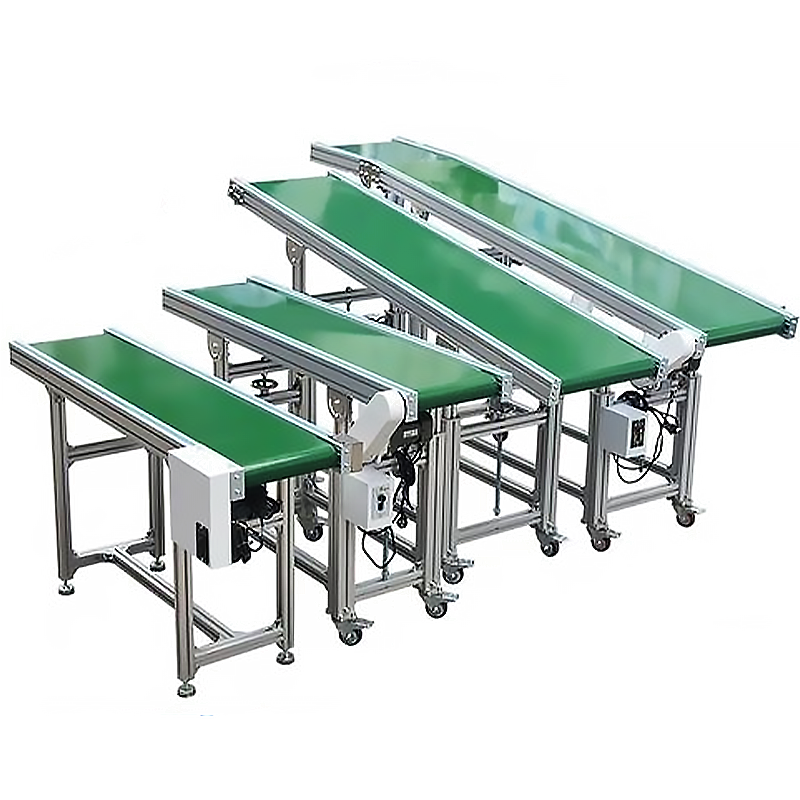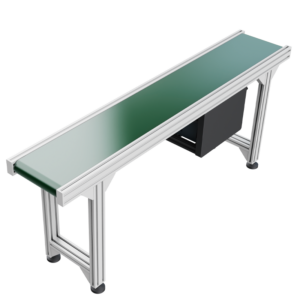Enhance your material handling with our belt conveyors’ reliability, adaptability, and simplified maintenance, driving your production line to new heights of efficiency.
Description
Extruded Aluminum Frame Belt Conveyors
Belt conveyors are adept at moving a range of items with varying weights either continuously or at intervals. Besides, they are distinguished by their uncomplicated build and cost-efficient operation. Often chosen for their smooth conveyance and minimal operational noise, they fit seamlessly into environments where noise reduction is prioritized.
Characteristics:
1. We design the belt for straightforward installation and effortless replacement.
2. Constructed from high-strength aluminum alloy profiles with standard notches, the frame facilitates ease of integration with other machinery. Or the addition of various components like sensors or support brackets.
Selecting the Right Aluminum Profiles for Belt Conveyors:
So the selection of aluminum profiles for conveyor belts hinges on the required load-bearing capacity. Typically, options range from the 4040 and 4080 series aluminum profiles for standard loads. Yet for greater load demands, sturdier profiles – such as the 5050, 50100, 6060 and 60120 series – are available, as well as the robust 80, 90, 100, and 120 series.
Distinctive Properties:
1. Frame Composition: The aluminum profile conveyor’s main fram is built with light yet robust aluminum alloy profiles. It offers flexible design modification for bespoke assembly and adjustment.
2. Material Movement: Employing chain, belt, or roller mechanisms for transportation, aluminum profile conveyors cater to the material’s nature and the specific conditions of the operational setting.
3. Adaptability: With adjustable features, heights, lengths, and we customize speeds to various workplace demands and spatial limitations on aluminum profile conveyors.
4. Efficiency and Eco-Friendly: Aluminum’s lightweight quality lowers energy use and lessens environmental impact during operation; these conveyors are synonymous with eco-conscious energy efficiency.
5. Versatility in Application: We extensively use aluminum profile conveyors across numerous industrial production lines. Include those in the food, beverage, machinery, electronics, and pharmaceutical sectors, capable of handling items from light to heavy.
6. Operator-Friendly: Known for their operational ease, stability, and reliability, aluminum profile conveyors can facilitate automatic control and the sorting and organization of materials.

Belt Conveyors Application and Usage
Aluminum profile conveyors are primarily utilized for the movement of lighter goods. Their design is lightweight and aesthetically pleasing, which makes them easy to maneuver. They are straightforward to upkeep and exceedingly functional. Regarding the belt, we typically use materials such as PVC and PU to suit various applications.
Meanwhile, these conveyors often come with optional enhancements like lifting baffles and side skirts to accommodate diverse processing needs. Additionally, they are capable of handling special materials that require oil resistance, anti-corrosion properties, or anti-static features.
Effectively integrating aluminum profiles into conveyor systems can markedly enrich the production environment of businesses. It eases the physical demands on workers involved in loading and unloading, paves the way for automated and mechanized production, and streamlines the processes within the logistics system’s distribution center.
The thoughtful application of these conveyors elevates material handling efficiency, trims logistics expenses, and bolsters the distribution center’s agility and robustness. This solid foundation supports the pursuit of impeccable quality assurance. And the aim for error-free distribution, reduction in paperwork towards paperless operations, and the enhancement of settlement processes.
Precautions for Using Belt Conveyors
Maintaining a conveyor belt requires careful attention to preserve its functionality and longevity. So to ensure proper maintenance, we should keep the belt conveyors clean. And we should store them in a way that shields it from exposure to harsh weather elements. Such as sunlight, rainfall, or snow. It’s crucial to store the conveyor belting away from contact with substances that can damage it.
Such as acids, alkalis, oils, and organic solvents, and to maintain at least a one-meter distance from any heat sources. When storing bellt conveyor, it’s advisable to keep the storage area’s temperature between 18-40°C and to regulate the relative humidity to rest between 50-80%. Meanwhile we should store belt conveyors in a rolled position to avoid any damage and not fold, turn over periodically—preferably every season—to prevent cracking or deformation.
It is equally important to avoid using belt conveyors of different types and specifications in tandem. And people should splice their connectors properly. The appropriate selection of the belt conveyors’ type, structure, specification, and number of plies is dependent on the intended use. Generally, belt conveyors should operate at a maximum speed of 2.5 m/s, with heavier, larger, and rough materials. Or when using fixed unloading devices at a reduced speed.
Other Notes
For conveyor systems tailored for daily chemical production, including moon cake packaging lines, proper tension adjustment is important. To correct misalignment, if the belt veers to the right of the head roller, adjust the right bearing housing forward. While if it shifts to the left, adjust the left bearing housing forward.
It is possible to also make corresponding rearward adjustments to the bearing seats. The relative height affects the horizontal speed component of the material as it impacts the lateral forces on the belt, making centering difficult. During adjustments, observe the belt’s movement carefully to identify the trend of deviation, adjusting each component as necessary, starting with the drive roller and the redirecting roller, and thereafter the idlers and the point at which the material is dropped onto the belt.
For the system to work properly, all rollers must be installed perpendicularly to the belt conveyor’s lengthwise centerline. Any significant deviation in the rollers can lead to the conveyor belt misaligning. Regular maintenance and precise adjustment of these components ensure the robust performance and durability of conveyors. Especially for those designed for demanding environments like daily chemical production.





